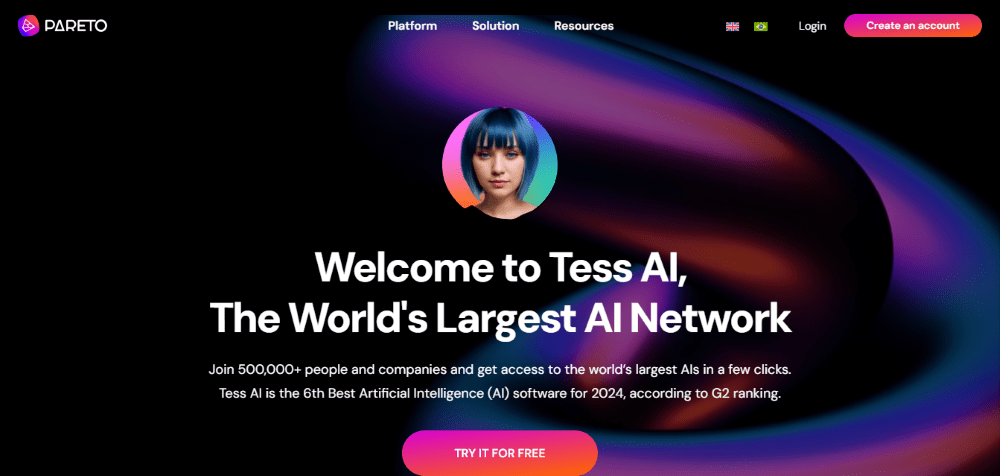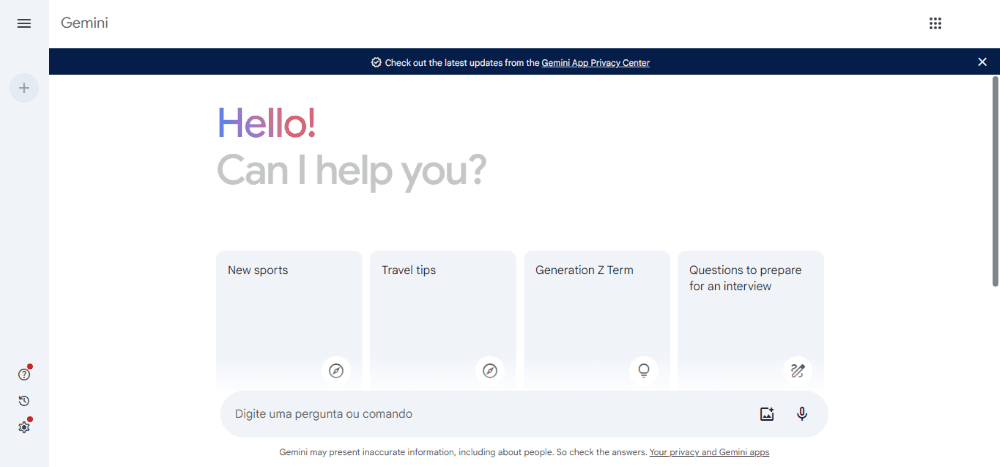Imagine using AI to create blog articles with the speed of thought and precision of an expert. Sound like a distant dream? Not anymore! Artificial intelligence is revolutionizing the way we produce content, making this dream a tangible reality.
In this article, we'll unlock the secrets of how to use AI correctly to boost your article production, turning ideas into engaging posts in a matter of minutes.
Do you want to discover how to multiply your productivity, overcome creative blocks and keep the quality of your blog at the top? Read on and learn how to master the art of creating articles with AI, taking your blog to new heights.
Benefits of Using AI to Create Blog Articles
The use of Artificial Intelligence (AI) in content creation offers several advantages for bloggers and digital marketers. Check out some of them:
- Time saving: AI can generate draft articles in a matter of minutes, much faster than a human writer. This frees up time for professionals to focus on tasks that require more creativity and strategy, such as content planning and audience engagement.
- Increased Productivity: with AI, it is possible to produce a greater volume of content in less time. This allows blogs and websites to maintain a higher frequency of publication, increasing online visibility and engagement with the public.
- Overcoming Creative Block: AI can provide suggestions for topics, angles of approach and even opening sentences for articles. This helps writers overcome the dreaded "writer's block" and maintain a constant flow of creative ideas.
- Consistency in Content Quality: AI tools are programmed to follow specific style and tone guidelines, ensuring consistency in the quality of the articles produced. This is especially useful for maintaining the brand's voice in large teams or with external collaborators.
- Ability to Generate Ideas Quickly: AI can analyze trends, news and data to suggest relevant and topical topics for articles. This helps content creators stay ahead of trends and produce content that resonates with their target audience.
- Ease of Searching and Compiling Information: AI tools can quickly search, filter and compile relevant information from a variety of sources. This significantly reduces the time spent on research and allows writers to focus on analyzing and presenting information.
- SEO optimization: many AI tools are equipped with search engine optimization features. They can suggest relevant keywords, optimize the content structure and ensure that articles comply with SEO best practices, potentially improving ranking in search results.
- Adaptability to Different Writing Styles: AIs can be trained or configured to emulate different writing styles, from a more formal and academic tone to a more casual and conversational style. This allows content creators to easily adapt their material for different audiences or platforms.
- Possibility of Creating Content in Multiple Languages: with the use of AI, it is possible to generate content in several languages without the need to hire human translators for each language. This facilitates expansion into international markets and increases the global reach of the content.
Top AI Tools for Blog Article Creation
The market offers several powerful AI tools to help you create blog articles, each with its own unique advantages. Check them out:
Tess AI

Tess AI is an artificial intelligence orchestrator that integrates the world's leading AIs, such as ChatGPT, Gemini, Claude AI and Llama, into a single platform. This union provides robust and versatile text generation, taking advantage of the best of each AI.
With Tess AI, you can create high-quality blog articles, optimized for SEO and adjusted to your desired style and tone. The integration of multiple AIs guarantees creative, coherent content that is highly relevant to your needs.
What's more, you can generate images for your articles with a simple prompt - like the header of this content, created with the description of a woman in a corporate environment.
Claude AI

Claude AI, developed by Anthropic, is known for its exceptional ability to generate high-quality content and carry out in-depth analysis. For blog article creators, Claude AI stands out for its ability to produce long, coherent texts while maintaining a high level of contextualization.
Her nuanced understanding of complex topics makes her ideal for blogs that tackle technical subjects or require more detailed analysis.
Claude AI is also effective at maintaining a consistent writing style throughout long articles, which is crucial for blogs looking to establish a strong authorial voice.
Gemini

Gemini, created by Google, brings a multimodal approach to creating content for blogs. Its ability to process and integrate information from different formats (text, image, audio) allows for the creation of richer, more interactive articles.
For bloggers, Gemini offers the advantage of being able to generate textual content based on visual or auditory inputs, which can be particularly useful for blogs that work with visual themes or want to incorporate media analysis into their articles.
In addition, its deep integration with the Google ecosystem can offer valuable insights into search trends and SEO.
ChatGPT

ChatGPT, developed by OpenAI, is one of the best-known AI tools for creating textual content. Especially effective in generating blog articles, ChatGPT uses state-of-the-art language models to produce fluent and coherent texts.
Its flexibility allows you to adapt the content to different styles and tones, ensuring that the articles are interesting and informative.
ChatGPT is ideal for bloggers looking for efficiency and quality in the production of their texts, offering support for brainstorming, creating drafts and final editing.
Step by Step on How to Use AI to Create Blog Articles
Creating blog articles with AI involves a series of strategic steps to ensure quality and relevant content. Check them out!
- Research Relevant Information: Before starting the process with AI, do comprehensive research on the topic. Collect up-to-date data, statistics and information from reliable sources. This will provide a solid basis to guide the AI and ensure that the content generated is accurate and valuable.
- Define Assertive Prompts: create clear and specific prompts for the AI. The more detailed and targeted your prompt, the better the results. For example, instead of asking "write about digital marketing", try "create a 1000-word article on the top 5 digital marketing trends for small businesses in 2024, including practical examples".
- Define the Topic and Keywords: determine the main topic of the article and identify relevant keywords. This will help the AI focus on the right subject and optimize the content for SEO. Include a mix of main and secondary keywords related to your niche.
- Define the Persona: provide AI with information about your target audience. Describe your blog's ideal persona, including age, interests, level of knowledge on the topic and challenges they face. This will help the AI adapt the tone and content to resonate better with your readers.
- Provide references for the AI to draw on: share with the AI links to reliable articles, case studies or relevant research on the topic. This will help the AI generate more substantiated and up-to-date content, increasing the credibility of your article.
- Ask the AI to Build a Briefing From This: Ask the AI to create a briefing or detailed outline of the article based on the information provided. This will serve as a structured guide for the development of the content, ensuring that all the important points are covered.
- Maintain Authenticity and Originality: review AI-generated content and add your unique perspective. Include personal examples, industry insights or opinions based on your experience. This helps maintain the authenticity of your blog and avoids generic content.
- Check Facts and Information provided: always check the accuracy of the information generated by AI. Confirm statistics, dates and facts from reliable sources. This is crucial to maintaining the credibility of your blog and avoiding the spread of incorrect information.
- Adjust the tone and style of the article: adapt the AI-generated content to match the tone and style of your blog. If your blog has a more casual, conversational tone, adjust the text to reflect this. Make sure the article sounds consistent with your brand voice.
- Add a Human Touch to the Text: incorporate elements that show the human perspective. Add personal anecdotes, more personalized introductions, informed opinions or recent real-life examples (this helps create a deeper connection with readers).
- Define the CTA: conclude your article with a clear and relevant Call-to-Action. Determine what you want readers to do after reading the article - whether it's sign up for a newsletter, download an e-book or leave a comment. Ask AI to suggest effective CTAs and choose the one that best aligns with your objectives.
How to Optimize a Blog Article for SEO
Optimizing content for search engines is crucial to increasing online visibility, and AI can be a powerful ally in this process:
- Generate attractive titles: use AI to create multiple variations of titles that include your main keywords. For example, ask: "Generate 5 SEO-friendly titles for an article on the 'benefits of meditation for productivity at work', including the main keyword."
- Impact analysis: ask the AI to analyze the generated headlines for emotional appeal, clarity and click-through potential. You could ask: "Rate these headlines in terms of SEO and attractiveness to the reader, ranking them from 1 to 5".
- Creating Optimized Meta Descriptions: ask the AI to create meta descriptions that summarize the content of the article and include the main keyword. For example: "Create a 155-character meta description that summarizes the main points of the article and includes the phrase 'meditation at work'".
- Variation testing: use AI to generate and test different combinations of titles and meta descriptions. Ask: "Create 3 different title and meta description pairs for this article, focusing on maximizing the CTR (click-through rate)."
Conclusion
The future of content creation is intrinsically linked to artificial intelligence, marking a new era in the production of blog articles and other forms of digital communication.
AI is not only transforming the way we create content, it is also redefining the limits of efficiency and creativity in this process. Embracing this technology is not just an option, but a necessity for those who wish to remain competitive in the rapidly evolving digital landscape.
So, are you ready to revolutionize your content creation? Try Tess AI today and discover how you can take your blog to the next level with the power of several integrated AIs.
This article was made with 80% support from Tess AI. Like the result? Try our platform now and transform the way you create content!




